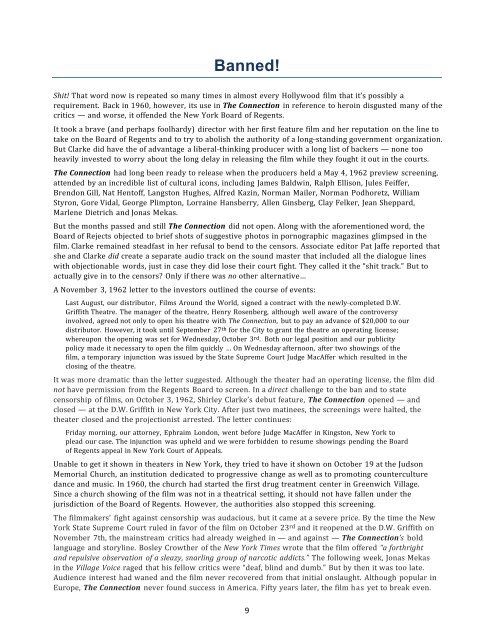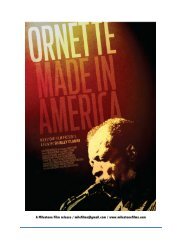Press Kit - Shirley Clarke
Press Kit - Shirley Clarke
Press Kit - Shirley Clarke
Create successful ePaper yourself
Turn your PDF publications into a flip-book with our unique Google optimized e-Paper software.
Banned!<br />
Shit! That word now is repeated so many times in almost every Hollywood film that it’s possibly a <br />
requirement. Back in 1960, however, its use in The Connection in reference to heroin disgusted many of the <br />
critics — and worse, it offended the New York Board of Regents. <br />
It took a brave (and perhaps foolhardy) director with her first feature film and her reputation on the line to <br />
take on the Board of Regents and to try to abolish the authority of a long-‐-‐-‐standing government organization. <br />
But <strong>Clarke</strong> did have the of advantage a liberal-‐-‐-‐thinking producer with a long list of backers — none too <br />
heavily invested to worry about the long delay in releasing the film while they fought it out in the courts. <br />
The Connection had long been ready to release when the producers held a May 4, 1962 preview screening, <br />
attended by an incredible list of cultural icons, including James Baldwin, Ralph Ellison, Jules Feiffer, <br />
Brendon Gill, Nat Hentoff, Langston Hughes, Alfred Kazin, Norman Mailer, Norman Podhoretz, William <br />
Styron, Gore Vidal, George Plimpton, Lorraine Hansberry, Allen Ginsberg, Clay Felker, Jean Sheppard, <br />
Marlene Dietrich and Jonas Mekas. <br />
But the months passed and still The Connection did not open. Along with the aforementioned word, the <br />
Board of Rejects objected to brief shots of suggestive photos in pornographic magazines glimpsed in the <br />
film. <strong>Clarke</strong> remained steadfast in her refusal to bend to the censors. Associate editor Pat Jaffe reported that <br />
she and <strong>Clarke</strong> did create a separate audio track on the sound master that included all the dialogue lines <br />
with objectionable words, just in case they did lose their court fight. They called it the “shit track.” But to <br />
actually give in to the censors? Only if there was no other alternative… <br />
A November 3, 1962 letter to the investors outlined the course of events: <br />
Last August, our distributor, Films Around the World, signed a contract with the newly-‐-‐-‐completed D.W. <br />
Griffith Theatre. The manager of the theatre, Henry Rosenberg, although well aware of the controversy <br />
involved, agreed not only to open his theatre with The Connection, but to pay an advance of $20,000 to our <br />
distributor. However, it took until September 27 th for the City to grant the theatre an operating license; <br />
whereupon the opening was set for Wednesday, October 3 rd . Both our legal position and our publicity <br />
policy made it necessary to open the film quickly … On Wednesday afternoon, after two showings of the <br />
film, a temporary injunction was issued by the State Supreme Court Judge MacAffer which resulted in the <br />
closing of the theatre. <br />
It was more dramatic than the letter suggested. Although the theater had an operating license, the film did <br />
not have permission from the Regents Board to screen. In a direct challenge to the ban and to state <br />
censorship of films, on October 3, 1962, <strong>Shirley</strong> <strong>Clarke</strong>’s debut feature, The Connection opened — and <br />
closed — at the D.W. Griffith in New York City. After just two matinees, the screenings were halted, the <br />
theater closed and the projectionist arrested. The letter continues: <br />
Friday morning, our attorney, Ephraim London, went before Judge MacAffer in Kingston, New York to <br />
plead our case. The injunction was upheld and we were forbidden to resume showings pending the Board <br />
of Regents appeal in New York Court of Appeals. <br />
Unable to get it shown in theaters in New York, they tried to have it shown on October 19 at the Judson <br />
Memorial Church, an institution dedicated to progressive change as well as to promoting counterculture <br />
dance and music. In 1960, the church had started the first drug treatment center in Greenwich Village. <br />
Since a church showing of the film was not in a theatrical setting, it should not have fallen under the <br />
jurisdiction of the Board of Regents. However, the authorities also stopped this screening.<br />
The filmmakers’ fight against censorship was audacious, but it came at a severe price. By the time the New <br />
York State Supreme Court ruled in favor of the film on October 23 rd and it reopened at the D.W. Griffith on <br />
November 7th, the mainstream critics had already weighed in — and against — The Connection’s bold <br />
language and storyline. Bosley Crowther of the New York Times wrote that the film offered “a forthright <br />
and repulsive observation of a sleazy, snarling group of narcotic addicts.” The following week, Jonas Mekas <br />
in the Village Voice raged that his fellow critics were “deaf, blind and dumb.” But by then it was too late. <br />
Audience interest had waned and the film never recovered from that initial onslaught. Although popular in <br />
Europe, The Connection never found success in America. Fifty years later, the film has yet to break even. <br />
<br />
9




